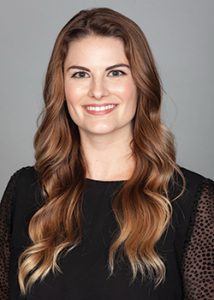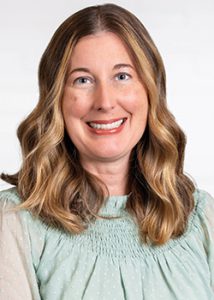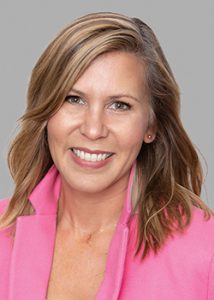Insurance Marketing Boosted

INSURANCE MARKETING, BOOSTED
IMCA Trailblazer Award recipients discuss
careers and communication innovations
By Lori Widmer
To win an Insurance Marketing & Communications Association (IMCA) Trailblazer Award means that the individual is someone who has made “outstanding contributions to” and demonstrated leadership in the insurance marketing and communications industry. Those who demonstrate special creativity or marketing and communications ability are those who also set the standard for others to follow, says the IMCA award description.
Three such industry professionals received the 2022 Trailblazer Award for their exemplary work in insurance marketing and communications. Nominated by their peers, each one has excelled at driving innovation, communication, and change within their respective organizations. As such, they have insights into what makes a winning insurance communication strategy.
We sat down with these Trail-blazer Award recipients to get a sense of who they are, what they bring to their companies, and what the communication innovations and practices are that they believe will reshape the industry for the better.

“[T]ools like ChatGPT allow
marketers to be more efficient. It’s not about AI taking over content development, but
rather helping with speed and clarity, ultimately
freeing up more time for strategy.”
—Taylor Evans
Manager, Marketing and Communications
IAT Insurance
Bringing brand into focus
For Taylor Evans, marketing and communications is an ever-evolving field that’s exciting and full of potential. Evans, a manager of IAT Insurance’s Marketing and Communications division, feels ignited by what she calls a key gamechanger in the industry—technology, specifically video and artificial intelligence (AI).
Evans began her career at IAT Insurance as a corporate communications specialist. Just six short years later, the University of North Carolina Wilmington alum is now helping head up the company’s marketing and communications efforts, which include everything from internal to external digital content creation.
Today, she leads marketing and communication strategies for IAT’s Commercial Transportation, Surety, Inland Marine, Property, and Aviation sectors. With a strong public relations and social media foundation from her first career stint with an advertising agency, Evans has leveraged the ability to work with several clients in various industries to understand the nuances that come from multiple insurance business classes. Making the move to a corporate marketing role, Evans says, “I wanted to have the opportunity to dive headfirst into one brand.”
During her tenure at IAT, Evans has not only helped develop a marketing team, but also has put in place a brand recognition strategy. “We were considered a family of acquisitions,” Evans says. “My role at IAT since joining six years ago has been to help change that,” which she accomplished by developing an internal voice and brand.
That kind of strategy is exactly why Evans is a 2022 IMCA Trailblazer Award recipient, and why she was awarded four internal awards for her campaign success and for teamwork. To Evans’s credit, she has delivered communication support during the pan-demic, revamped the company intranet to make it a go-to resource that engages and informs employees, created and led successful marketing campaigns with innumerous IAT business units, and created and drove the IAT branding—Insurance Answers Together.
Attention to culture is, in Evans’s estimation, crucial to fostering a successful brand. “The culture informs the brand,” she says. Building a strong brand “starts from the inside and is a never-ending journey.” She suggests that employees have input into the efforts to create a brand and promote it.
Her advice for any company: “Go outside of your bubble and make every effort to get to know the people that make up your organization. They are the boots on the ground and the walking embodiment of your brand.”
Evans says technology tools such as video and AI can give companies with smaller budgets the ability to increase brand recognition. “Short-form video offers more engaging, concise ways to deliver information and expose stakeholders to your brand. For us, it’s been instrumental in demonstrating our authenticity and telling our brand story.”
That said, Evans believes that writ-ten content is still necessary. With the advent of AI-generated content, she believes AI can help marketers improve efficiency. “[T]ools like ChatGPT allow marketers to be more efficient. It’s not about AI taking over content development, but rather helping with speed and clarity, ultimately freeing up more time for strategy.”

“There will always be complexities
that need to be communicated and compliance
guidelines that must be upheld when writing for a
publicly traded insurance company, yet I love the overall conversational
tone and transparency that exists in much of our business writing today.”
—Jacqueline Teahen
Senior Copywriter
UFG Insurance
Going big by going simple
Jacqueline Teahen is proof that writing is still essential to the marketing function. Teahen, senior copywriter at UFG Insurance, was nominated for the 2022 Trailblazer Award by her colleague, Kelli Sanders, who wrote: “Jacq’s pen has been behind some of the communications that UFG agents depend upon most, like the P&C Connections newsletter, incentive news and communications critical to doing business.” According to Sanders, Teahen’s writing style has “brought UFG’s brand to life” and drove efforts to launch and improve products and web portals critical to the company’s success.
Her talent has also been an integral part of many of UFG’s major events and milestones. Be it flood (2008, when UFG’s Cedar Rapids office was hit by cata-strophic flooding), pandemics, or even a derecho that hit the area in 2020, Teahen and team worked to provide daily communications, informing employees and keeping them abreast of any developments.
Teahen, a native of Cedar Rapids, Iowa, and a University of Iowa alum, employs messaging that evokes trust through a more uncomplicated style. “Early in my writing career, there was a lot of talk about the need to write in plain language that all could easily understand—a concept that I feel has been strongly embraced by the insurance industry over the years,” she says.
Her conversational tone, she says, delivers clarity that cuts through the often complicated language of insurance. “There will always be complexities that need to be communicated and compliance guidelines that must be upheld when writing for a publicly traded insurance company, yet I love the overall conversational tone and transparency that exists in much of our business writing today.”
That is a trend that Teahen sees continuing. As the industry sees greater consumer engagement from the more straightforward, simpler communication efforts, the perception of the industry will change, she adds. “I believe if people have a better understanding of the insurance industry and the important purpose it serves in our economy, we can change some of the negative perceptions that persist of our industry.”
She credits social media in particular for the ability of insurers and industry organizations to “tell their story and share their brand in a more personal and compelling way.” That, she says, helps organizations connect with every stakeholder, from employees and partners to customers and communities on a level not possible prior to social media.
Organizations today have a golden opportunity to connect, and Teahen suggests making communication more personal. “It’s simple, but I always try to put myself on the receiving end of any communication I’m working on, whether for employees, insurance agents, policyholders or shareholders.”
That, she says, is a page from Marketing 101. “It all goes back to knowing your audience and striking the right tone. When I don’t know the audience as well as I’d like, I rely on our company’s many subject matter experts—it always amazes me how much I can glean from simply sitting in on meetings with the people who are actually out in the field serving our agents and policyholders. I owe many of my lightbulb moments to them.”

“Marketing used to be very
assumptive. If sales grew after an
advertising campaign, we considered it a job well done.
Now we know exactly how people are responding.”
—Holly Bohn Pittman
Executive Vice President, Marketing, and Chief Marketing Officer
The Fortegra Group
Smart innovation
For Holly Bohn Pittman, technology can be a lightbulb moment, but only if used in the right doses. Pittman, a California State University alum, is a big believer in innovation, but she cautions strongly against what she calls “all-or-nothing thinking.”
As the executive vice president of Marketing and the chief marketing officer at The Fortegra Group, Pittman says technology is a tool that some don’t see the benefit of and others apply heavily and without much insight into its use. She describes marketers who may be relying on tools such as ChatGPT to write their content. “We have to keep it in perspective. We are so enamored with technology and innovation, but we have to remember it is just a tool.” With communication and market-ing, Pittman says that organizations need to “understand the limitations, and still apply that personal touch.”
Within the organization, Pittman has overhauled the company’s branding, websites, and social media, and has incorporated AI and other technologies to improve on processes, not to take over processes. It’s an approach that’s working; Within just two years at the firm, she has doubled the size of Fortegra’s marketing team, taken on oversight of the Learning and Development department, and helped launch Fortegra’s NOW initiative, which develops female leaders and their allies.
Her innovation is well demonstrated by her launching of her office supply product line, See Jane Work. In 2004,Pittman realized that women personalized their workspaces. She envisioned a line of supplies that would be practical, yet enjoyable. Yet, not everyone was onboard. “People said, ‘You’re crazy. No one cares about their office supplies.’ But as I continued to do research, I dis-covered that more than 80% of all office supplies are purchased by women. ”That crazy idea is now a multimillion-dollar retail brand.
Growing brands, therefore, is something Pittman understands well. For her, three innovations stand out as ones the insurance industry should be noticing.
The rise of social media as a marketing tool can no longer be ignored, in her estimation. “Platforms such as Facebook, Twitter, Instagram, and LinkedIn are now some of the most prominent channels for companies to increase visibility, directly engage with their audiences and foster brand advocacy,” Pittman says. “For consumers, the conversational nature of social media has ushered in a new era—customers are now more informed and empowered than ever. As a B2B marketer, I’m pleased that social media has evolved to include business-focused platforms such as LinkedIn.”
Also on her radar: mobile marketing. “With the rise of location-based services, companies have been able to target customers based on their physical location. It has enabled companies to create relevant, interactive, and engaging content that customers can access any-time, anywhere—omnichannel on an entirely new level.” Pittman says these access points can include in-app advertising, mobile web advertising, mobile messaging and mobile search ads.
Yet, the one innovation that has her most excited is the rise of AI as a marketing tool. Automating and optimizing marketing efforts through AI can bring more efficiency through identifying customer behaviors and preferences quickly.
“These innovations help marketers to monitor customer behavior in real time, provide consumers with increasingly personalized content, and create more meaningful brand experiences,” says Pittman. The advantages for the consumer are clear, she says. They can receive tailored product recommendations that save them hours of research, and they can offer feedback that can enhance their own user experience and improve marketing efforts. AI can engage customers and help them make better decisions. Also, “AI-powered chatbots can provide customers with 24/7 support,” she adds.
AI can help measure ROI, too. That in itself will deliver better marketing results, and Pittman says it will bring with it a competitive advantage. “Marketing used to be very assumptive. If sales grew after an advertising campaign, we considered it a job well done. Now we know exactly how people are responding,” thanks to click-through rates and other precise metrics.
While some branding and marketing efforts remain tough to measure, Pittman says technology is the game-changer for the insurance industry. “Technology has allowed marketers to build more informed strategies.”
Even so, the best strategies, she says, are the basics. “[U]nderstanding your value proposition and knowing your audience.” From there, compelling brands are born, she says, and target customers are won. “Of course, data-driven decision-making is key, but it all begins with fostering an emotional connection to the brand through storytelling. What is that story, and who are you telling?
For more information:
Insurance Marketing & Communications Association
www.imcanet.com
The author
Lori Widmer is a Philadelphia-based writer and editor who specializes in insurance and risk management.











